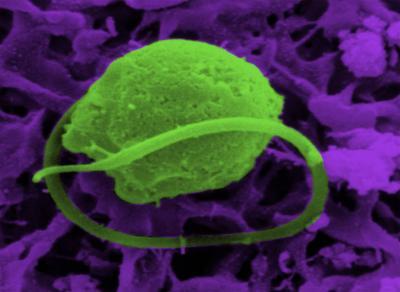Millions of years ago, tiny animal thieves going by the alias protozoa held algae captive and then exploited and stole their genes for energy production, thereby evolving into a new and more powerful species.
But the little protozoan outlaws couldn't completely hide all evidence of the captive algae and have been effectively frozen in time - and then caught in the act by genetic sequencing.
The protozoa captured genes for photosynthesis, the process of harnessing light to produce energy which is used by all plants and algae on earth. Scientists assume that quantum leaps of evolution occurred by one organism cannibalizing another, but hard evidence is rare.

Electron micrograph of Bigelowiella natans. Credit: Paul Gilson
But when they looked at two specific algae- Guillardia theta and Bigelowiella natans- the team realized the evolution was not quite complete. They could see that their cells had two nuclei. This is unusual because plant and animal cells only have one, so the genes were sequenced to find out more.
"We think that the genes for photosynthesis originally evolved only once about three billion years ago. So all plants, algae and blue green bacteria can produce their own energy from light because they have acquired these genes for photosynthesis," says Professor Geoff McFadden from the University of Melbourne.
Like prisoners in Alcatraz, the captive algae appear to have been nurtured by their enslavers and the precious sugars produced from photosynthesis became a vital part of the protozoan slave keeper's diet. The captives lived inside the protozoan cell and, under the right conditions, the pair gradually became unified as a single organism- a process called endosymbiosis, literally living inside each other.
"We discovered that the captors were initially able to keep many separate clones of their slaves and occasionally pillage one or two for most of the essential genes. However, at some point in time, the number of captives reduced inside each gaoler to just one individual.
"So if they broke into the alga's cell to steal the last essential genes, they would destroy it in
the process and would not then be able to use the genes to run photosynthesis. So the two cells, one captive and one captor, had apparently reached an evolutionary stand-off situation where both are dependent on each other to survive."
Published in Nature.




Comments